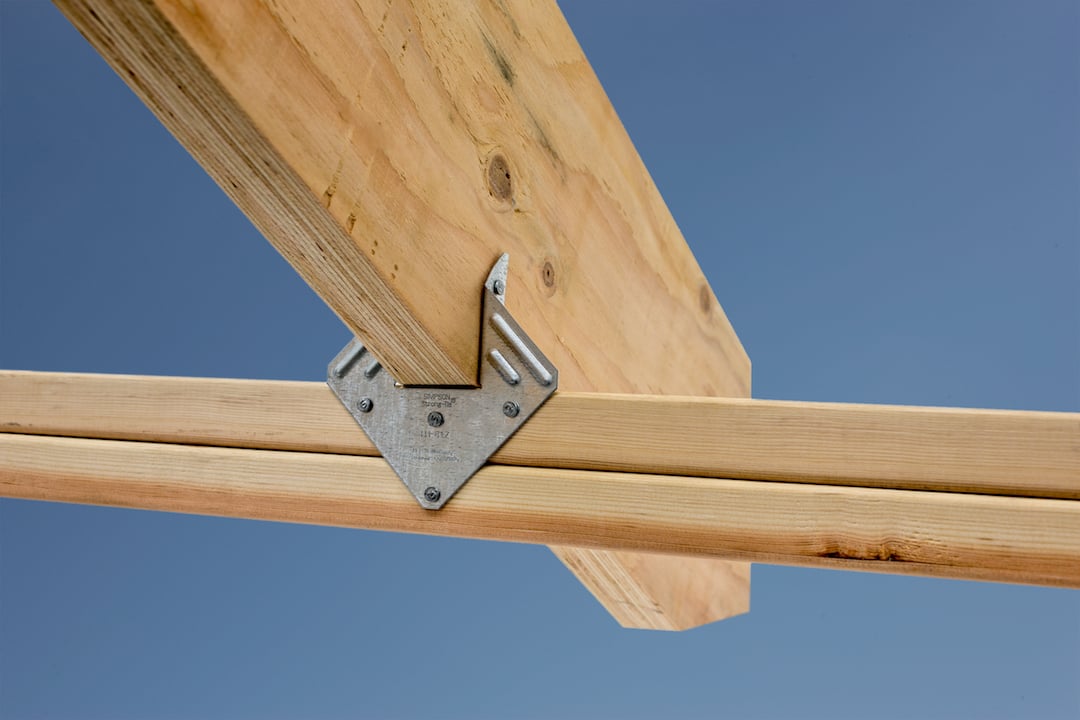
Florida homeowners are no strangers to hurricane season and the devastating impact these storms can bring both to homes and public infrastructure. Each year, powerful winds, torrential rain, and flying debris test the strength of houses across the Sunshine State. One of the simplest yet most effective defenses against hurricane damage is a small metal connector known as a hurricane tie.
At Jack C. Wilson Roofing Co., Jacksonville’s oldest roofing company, we know how critical proper roof care can be for protecting and anchoring your home. We’re here to keep you informed and confident in your knowledge of hurricane preparations. Read on to learn more about what hurricane ties are, why they’re important, how they’re installed, and what certain building codes require for certain areas.
What are Hurricane Ties?
Hurricane ties, also referred to as hurricane clips or connectors, are metal fasteners designed to strengthen the connection between your home’s roof and its walls. Typically formed from galvanized or stainless steel to resist corrosion and provide long-term durability, these connectors can drastically change the outcome of damage after a storm.
These ties come in various configurations depending on the construction of your home, but their main purpose is always the same: to resist uplift and lateral forces caused by high winds. In simpler terms, they help keep your roof attached to your house when powerful winds try to tear it off.
Why are Hurricane Ties Important?
To understand why hurricane ties matter, let’s take a meteorological lens to the science behind hurricanes.
Under pressure
When hurricane-force winds hit a home, the air pressure can build up underneath the eaves of the roof, which in turn ends up lifting it like the lid of a box. Wind speeds in hurricanes can exceed 120 mph or more, creating uplift forces that can remove a poorly anchored roof in seconds.
A look at the numbers
Jacksonville and surrounding areas are no strangers to storms like Hurricane Irma (2017), which brought sustained winds of more than 100 mph and caused billions in property damage across Florida. The National Oceanic and Atmospheric Administration (NOAA) predicts an increase in both the frequency and intensity of storms due to warming ocean temperatures.
- Category 1 hurricane winds: 74–95 mph
- Category 3 hurricane winds (major hurricane): 111–129 mph
- Category 5 hurricane winds: 157+ mph
Preparing your home for future storm intensities not only protects your property and investments, but more importantly keeps you and your family safe with a heightened peace of mind.
Roof-to-ground structural integrity
This is where hurricane ties come in. They help create a continuous load path, meaning the forces acting on your roof are transferred all the way down through the walls to the foundation. This structural integrity can mean the difference between a home that weathers the storm and one that’s left in ruin.
Where are Hurricane Ties Typically Installed?
Hurricane ties are usually outfitted in key areas of your home’s framing:
- At the connection between roof trusses or rafters and the top wall plates
- At each truss or rafter location along the exterior walls
- At gable ends, where wind pressure is especially strong
- In attic spaces, where reinforcement is often easier to access in retrofit projects
During installation, hurricane ties are fastened with galvanized nails or structural screws according to manufacturer and code specifications. Proper installation is critical as misaligned or improperly nailed ties won’t provide the protection they’re designed to deliver.
At Jack C. Wilson Roofing Co., we approach each install with expertise and care, and in the case of hurricane tie implementation, we’re sure each tie is installed with precision and inspected thoroughly before completion.
Are Hurricane Ties Required by Building Codes?
Yes. In hurricane-prone areas like Florida, hurricane ties are not just recommended — they’re required as a means of protecting you, your neighbors, and the local businesses.
The Florida Building Code (FBC) mandates the use of approved connectors to resist wind uplift forces in new construction and in major roof repairs or retrofits. Specific code requirements vary by wind zone, building type, and occupancy category, but in most residential structures, hurricane ties must be installed at every roof-to-wall connection.
Why it matters for you:
- Insurance discounts may be available for homes with proper wind mitigation systems, including hurricane ties.
- Permits for roof replacement often require hurricane tie inspection and installation.
- Peace of mind during hurricane season knowing your roof is securely anchored.
If your home was built before the early 2000s, it might not meet today’s stricter code requirements. That’s why it’s important to have your roof evaluated by an experienced professional.
How Can You Tell if Your Home Has Hurricane Ties?
If your home was built after 2002, there’s a good chance it already has hurricane ties. However, older homes often lack proper connectors, or may have outdated ones. The only way to know for sure is with a roof or attic inspection.
At Jack C. Wilson Roofing Co., we offer thorough roof assessments and can determine if your home is protected or if upgrades are needed.
Protect Your Home with Jacksonville’s Trusted Roofing Experts
In a state where hurricane threats are yearly events, every layer of protection counts. Hurricane ties are a cost-effective, code-approved, and storm-studied solution to safeguarding your home.
Whether you’re replacing your roof, building a new home, or upgrading for insurance purposes, we’re here to help. Our team at Jack C. Wilson Roofing Co. brings more than 75 years of experience serving homeowners across Jacksonville and Northeast Florida.
Contact us today for a quote or to schedule a hurricane tie inspection.
Jack C. Wilson Roofing Co. — Protecting Jacksonville Homes Since 1946.

